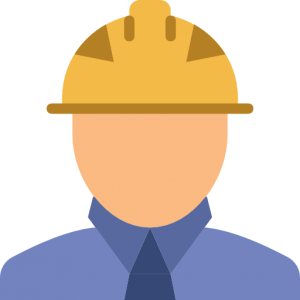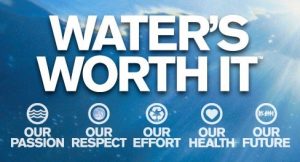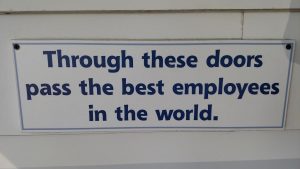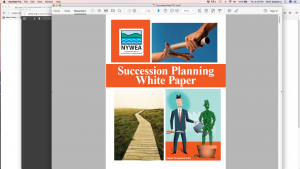 Written by: Khris Dodson
Written by: Khris Dodson
Khris Dodson is the Associate Director at the Syracuse University Environmental Finance Center
Your people are your #1 Asset.
Well, maybe your #2 asset behind your actual facility. But, without good people, in time, you will likely not have a good facility either.
So, how do you find and keep good people? That’s called Workforce Planning. Essentially, we break that down into 4 components: Creating a Message, Recruitment, Retention, and Succession Planning.
 Creating a Message: Clean, affordable water is often a forgotten service that many don’t think about until that service is disrupted. Folks also don’t want to pay for what they don’t see, or take for granted. For years the industry has not been able to communicate its value. Only recently have there been campaigns talking about the value of water. Water is Life. But, when folks talk about infrastructure, they talk about roads and bridges, not pipes and pumps. There is still more work to be done and you can be a part of that by talking positively, loudly and proudly about the industry. Do we attract new recruits by telling them how to avoid conflict by not sharing the pride of their work with their community? Or, do we attract recruits using a positive message demonstrating the industry’s critical value to the community?
Creating a Message: Clean, affordable water is often a forgotten service that many don’t think about until that service is disrupted. Folks also don’t want to pay for what they don’t see, or take for granted. For years the industry has not been able to communicate its value. Only recently have there been campaigns talking about the value of water. Water is Life. But, when folks talk about infrastructure, they talk about roads and bridges, not pipes and pumps. There is still more work to be done and you can be a part of that by talking positively, loudly and proudly about the industry. Do we attract new recruits by telling them how to avoid conflict by not sharing the pride of their work with their community? Or, do we attract recruits using a positive message demonstrating the industry’s critical value to the community?
Recruitment: If one of your staff left today, who would you turn to? How would you get the job done? Who would you hire? The standard and traditional ad placement in the paper is quickly falling by the wayside as papers are going away and online jobsites are growing in popularity. Websites like Monster.com and Indeed.com are becoming the first-stop for many job seekers. Social networks like LinkedIn.com provide professional connections to others in the industry, and professional organizations such as the American Water Works Association provide valuable networks as well. All of these tools have supplemented but now surpass traditional avenues for hiring: placing ads in the paper or hiring your nephew. Create a positive message, build, maintain, or expand your networks and recruitment will be easier. Consider internships, Community Colleges, and local Workforce Investment Boards as other areas to look for recruits. There are also federal programs that incentivize hiring veterans.
 Retention: What is the culture of your workplace? Do folks get along? Is the workplace comfortable and accommodating? How is communication? Do you conduct performance evaluations?
Retention: What is the culture of your workplace? Do folks get along? Is the workplace comfortable and accommodating? How is communication? Do you conduct performance evaluations?
Let’s face it, at times the workplace can be quite uncomfortable, especially in enclosed spaces and during inclement weather. This is all the more reason to make sure that controlled spaces are comfortable.
Open, honest communication and ongoing performance evaluation are also critical. Without good communication, it’s hard for staff to know what they are doing well, or not so well; likewise, it is hard for supervisors to understand the needs to staff. One way to not only have this communication but to document it is through performance evaluations. For the sake of brevity, a performance evaluation could look like this:
- Staff member fills out a self-evaluation and sets performance goals for the future;
- Supervisor reviews and responds, adjusts goals and provides input on past performance;
- Both meet and chat, agree on goals, sign and file away
- Both periodically review goals, performance and adjust as needed
Evaluations can be done in many different ways, but constant encouragement and communication help to be adaptable along the way; not just waiting a year to receive feedback during a formal performance evaluation.
 Succession Planning: People leave; they always do. So, you want to make sure that no vital knowledge leaves with them. Succession is an opportunity. It is an opportunity to look not only at that specific position, but other staff, level of service, and organizational structure. Maybe it’s time to make lateral moves within the organization, to do multi-skill training, or to hire from the outside. There are 5 major components of a succession plan:
Succession Planning: People leave; they always do. So, you want to make sure that no vital knowledge leaves with them. Succession is an opportunity. It is an opportunity to look not only at that specific position, but other staff, level of service, and organizational structure. Maybe it’s time to make lateral moves within the organization, to do multi-skill training, or to hire from the outside. There are 5 major components of a succession plan:
- Identify the positions you are planning for
- List out the necessary knowledge, skills, and abilities for each position (not the person in that role!)
- Assess existing staff: What knowledge, skills, abilities do they have, what role do they best fit, where do they see themselves going, where do you see them going?
- Do a gap analysis: Consider community dynamics, overall revenue vs expenditures. Where are you today with your staffing level and level of service? Where do you want to be, or think you will be, in the next 5-10 years with staff and level of service?
- Develop the plan, and constantly monitor, and update the plan as changes in staff and knowledge, skills and abilities occur.
The water industry is a great place to be, the jobs can’t be outsourced overseas. Providing a critical service to the community in which you may live is a powerful incentive to many up-and-coming young professionals. Develop a positive message, get out there, and develop a pipeline of potential workers and your #1 asset will do its best for your utility.

